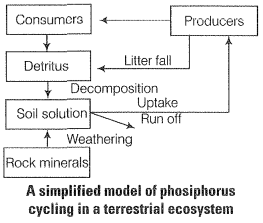Q.66 What is a biogeochemical cycle. What is the role of the reservoir in a biogeochemical cycle: 6ive an example of a sedimentary cycle with reservoir located in earth's crust.
Ans. Biogeochemical Cycle
(i) The movement of nutrien elements through the various components of an ecosystem is called nutrient cycling or biogeochemical cycles (Bio-living: geo-including air, water and rocks).
(ii) Nutrient cycles are of two types
(a) Gaseous (b) Sedimentary
(i) Atmosphere is the reservoir for gaseous type of nutrient cycle (e.g.. niluogen and carbon cycle).
(ii) Earth's crust is the reservoir of sedimentary cycle (e.g., sulphur and phosphorus cycle).
(iii) The function of the reservoir is to meet with the deficit, which occurs due to imbalance in the rate of influx and efflux.
(iv) Environmental factors, e.g., soil, moisture, pH, temperature, etc., regulate the rate of release of nutrients into the atmosphere.
Phosphorus Cycle
Phosphorus cycle is an example of sedimentary nutrient cycle since, it moves from land and sedimented at the bottom of the seas, then back to land again.
The natural reservoir of phosphorus is earth's crust. Rock contains phosphorus in the form of phosphates. By weathering and soil erosion, phosphates enter streams, rivers and then to oceans
With great movements of the crustal plates, sea flioor is uplifted and phosphates become exposed on the drained land surfaces. From here, weathering over long periods of time releases phosphates.
From rocks, minute amount of these phosphates dissolve in soil and are absorbed by the roots of the plants.
Herbivores and other animals obtain this element from plants when they consume plants as their food.
The waste products and the dead organisms are decomposed by phosphate-solubilising bacteria thus releasing phosphorus.


© 2026 GoodEd Technologies Pvt. Ltd.